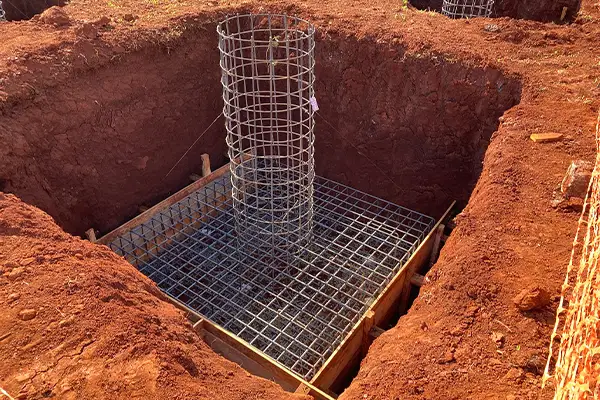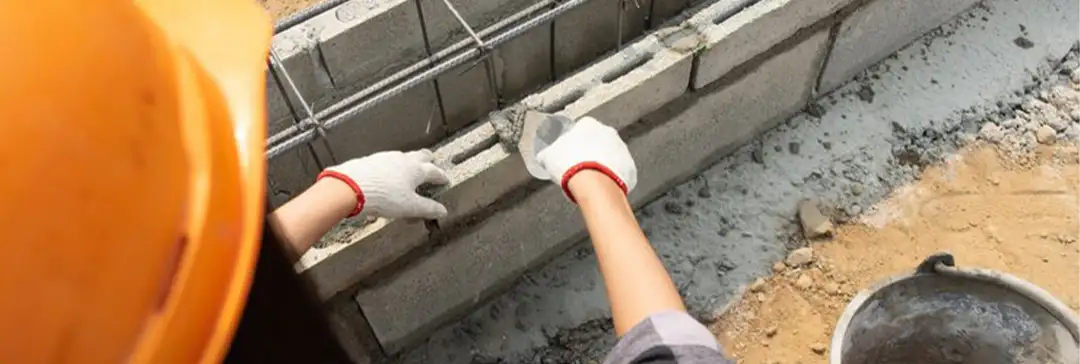As we all know, the foundation plays an important role in building construction. A foundation is a structural component of a building that supports and anchors the entire structure, transferring its load to the ground. It is the lower portion of a building, typically constructed below ground level and serves to distribute the building’s weight evenly to the soil or rock beneath it. The type of foundation needed depends on factors like soil, climate, and building design.
In India, the soil type varies from region to region, so it’s important to choose the right type of foundation based on factors like earthquake risk, bearing capacity of soil, and type of structure. Qualified engineers should conduct a thorough analysis to ensure the foundation meets site requirements and local building codes in earthquake-prone areas. A well-planned and strong foundation is essential for lasting and safe homes.
This blog gives you detailed information about shallow foundations, such as types of shallow foundations, their suitability, and the advantages and disadvantages of shallow foundations.
But, before proceeding to shallow foundations, it’s important to know the types of foundations:
Types of Foundation
The various types of foundations are used in construction, and the choice depends on factors such as soil conditions, building requirements, and local regulations. There are mainly two types of foundations used for house construction.
- Shallow Foundation
- Deep Foundation
What is a Shallow Foundation or Footing?
A shallow foundation, also known as “spread footings”, transfers loads of a building to the earth very near the surface rather than to deeper layers of soil or rock. These foundations are usually used for small, simpler structures such as houses and low-rise structures. It spreads the load of a building over a larger area closer to the surface, providing support without the need for extensive excavation.
Shallow footings are constructed where the soil can adequately support the structure without deep excavation. Their suitability depends on soil type, seismic activity, and project requirements. In India, technical analyses and structural reports are essential for determining which foundation is best for building houses.

Types of Shallow Foundations
Five types of shallow foundations are designed to suit specific construction requirements. They include:
- Individual /Isolated Footing
- Combined Footing
- Raft or Mat Foundation
- Strip Foundation
- Slab-on-Grade Foundation
1. Individual /Isolated Footing:
Individual or isolated footing is the most common type of shallow foundation for building construction. This type of foundation, also known as a pad foundation, is designed to support a single column.
The shape of individual footing is square or rectangular and is utilised when the columns carry the structure’s weight. The load on the column and the soil’s safe bearing capacity are considered when calculating the size.
Rectangular, isolated footing is chosen when the foundation encounters moments because of the eccentricity of loads or horizontal forces.
Particularly for Indian homes, isolated footings are a practical option because they are reasonably priced and adaptable. It is necessary to consider particular site conditions and consult an expert for the best results.
2. Combined Footing:
A combined footing is a foundation that helps to support two or more columns or walls by spreading the weight over a larger ground area. People use it when the columns or walls are close together, and the soil could be stronger.
They’re great for support and stability, but it’s important to think about the specific soil and climate conditions in India.
Experts should be involved in planning and designing combined footing for the best results in India’s diverse needs. There are several types of combined footings, and they are classified based on their shape and the arrangement of columns they support.
3. Raft or Mat Foundation:
A raft or mat foundation is like a big, flat slab on the ground under an entire building. It helps to support the construction and spreads its weight across the ground. Raft foundations are an excellent option to make sure the building stays stable, and the weight is distributed evenly. However, experts are needed because they can be challenging to build and may cost more, especially given the unique conditions in India.
4. Strip Foundation:
A strip foundation, or strip footing, is like a long, continuous strip of concrete under the walls and closely placed rows of columns that hold up a building. It spreads the weight of the walls and columns over the whole ground. The footing can be made of regular or more substantial reinforced concrete.
Strip foundations are good because they spread the weight well, save money, and work in different soils. Having professionals for design and construction, along with checking the ground, is important for successful strip foundations.
5. Slab-on Grade Foundation:
A slab-on-grade foundation is a kind of construction foundation in which the concrete is poured directly into the site, forming a solid slab that acts as the foundation for the structure that is built upon it. The term “on grade” refers to the fact that this type of foundation is installed without the need for significant excavation or the formation of a crawl space or basement directly on the natural grade of the construction site. For many kinds of buildings, it’s a popular foundation option, especially in areas where frost heave can occur because the ground doesn’t freeze far below the surface.
Slab-on-grade foundations are beneficial for their affordability, simplicity, and accessibility. In India, their suitability depends on soil type, climate, and project requirements. Professional construction and climate-specific design are important for success in India’s varied soil and climatic conditions.
Suitability and Applicability of Shallow Foundations
In India, shallow foundations, including spread footings and slab-on-grade foundations, are well-suited for various soil conditions. They can be effectively designed for cohesive soils like clay and granular soils like sand. The adaptability to diverse soil types makes them versatile for construction projects in regions with varying geological profiles.
Shallow foundations are commonly used in densely populated urban areas with limited space, and construction must often occur near existing structures. Cities like Mumbai, Chennai, and Kolkata frequently employ shallow foundations due to their practicality and efficiency in constrained spaces.
Shallow foundations are generally more cost-effective compared to deep foundations. The reduced excavation depth and simplicity of construction contribute to lower overall project costs, making them an attractive option for many construction projects.
Advantages of Shallow Foundation in Indian Soil and Climate:
Shallow foundations, including spread footings, slab-on-grade, and mat foundations, offer several advantages in construction projects.
Here are the key benefits of shallow foundations:
- Cost-Effective: Shallow foundations are generally more budget-friendly than deep foundations, requiring less excavation and materials.
- Speedy Construction: Shallow foundations can be built quickly, making them suitable for projects with tight deadlines.
- Accessibility: These foundations are easily accessible for inspections, maintenance, and repairs due to their proximity to the surface.
- Suitability for Light Structures: Shallow foundations are well-suited for supporting light to moderate-weight structures like residential buildings.
Disadvantages of Shallow Foundations in Indian Soil and Climate
While shallow foundations offer several advantages, it’s important to consider potential disadvantages associated with their use in construction projects. Here are some disadvantages of shallow foundations:
- Limited Load-Bearing Capacity: Shallow foundations may not be appropriate for heavy or tall structures, as the soil near the surface might not bear sufficient load.
- Sensitivity to Soil Changes: Shallow foundations can be sensitive to soil condition changes, like swelling or settling, affecting their stability.
- Not Ideal for Weak Soils: In weak or unstable soils, shallow foundations may need more support, leading to structural issues.
Conclusion
shallow foundations are a versatile and widely used solution in construction, offering advantages such as cost-effectiveness, ease of construction, and adaptability to various soil conditions.
Their suitability for light to medium loads and accessibility for inspection and maintenance make them particularly favourable for residential and smaller commercial structures.
The decision to use shallow foundations should be guided by a thorough understanding of project requirements, soil conditions, and the site’s specific challenges. Striking a balance between the benefits and drawbacks ensures informed decision-making, leading to the successful implementation of shallow foundations in diverse construction projects.
Although shallow foundations are becoming increasingly viable for more contemporary construction needs, deep foundations may still be necessary for multistory buildings in specific soil profiles due to the development of lightweight building materials and modular building systems.
Construction companies like as Brick&Bolt use cutting-edge materials and prefabrication techniques to create sturdy, high-quality structures that are securely supported by shallow foundation systems.

